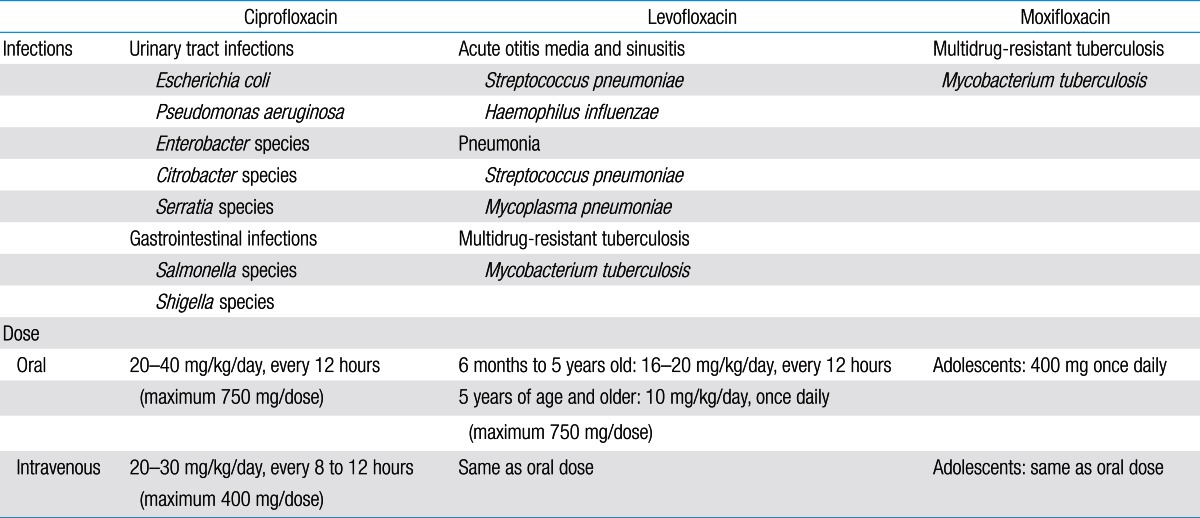1. Karande SC, Kshirsagar NA. Adverse drug reaction monitoring of ciprofloxacin in pediatric practice. Indian Pediatr 1992;29:181–188.

2. Lietman PS. Fluoroquinolone toxicities. An update. Drugs 1995;49(Suppl 2): 159–163.


3. Lipsky BA, Baker CA. Fluoroquinolone toxicity profiles: a review focusing on newer agents. Clin Infect Dis 1999;28:352–364.


4. Andriole VT. The quinolones: past, present, and future. Clin Infect Dis 2005;41(Suppl 2): S113–S119.


5. Grady RW. Systemic quinolone antibiotics in children: a review of the use and safety. Expert Opin Drug Saf 2005;4:623–630.


6. Bonafede ME, Blumer JL. Role of newer broad-spectrum beta-lactam and fluoroquinolone antibiotics in children. Adv Pediatr Infect Dis 1996;12:71–108.

7. White NJ, Dung NM, Vinh H, Bethell D, Hien TT. Fluoroquinolone antibiotics in children with multidrug resistant typhoid. Lancet 1996;348:547

8. Freifeld A, Pizzo P. Use of fluoroquinolones for empirical management of febrile neutropenia in pediatric cancer patients. Pediatr Infect Dis J 1997;16:140–145.


9. Redmond AO. Risk-benefit experience of ciprofloxacin use in pediatric patients in the United Kingdom. Pediatr Infect Dis J 1997;16:147–149.


10. Sáez-Llorens X, McCoig C, Feris JM, Vargas SL, Klugman KP, Hussey GD, et al. Quinolone treatment for pediatric bacterial meningitis: a comparative study of trovafloxacin and ceftriaxone with or without vancomycin. Pediatr Infect Dis J 2002;21:14–22.


11. Sideri G, Kafetzis DA, Vouloumanou EK, Papadatos JH, Papadimitriou M, Falagas ME. Ciprofloxacin in critically ill children. Anaesth Intensive Care 2011;39:635–639.


12. Sung L, Manji A, Beyene J, Dupuis LL, Alexander S, Phillips R, et al. Fluoroquinolones in children with fever and neutropenia: a systematic review of prospective trials. Pediatr Infect Dis J 2012;31:431–435.


13. Schaad UB. Fluoroquinolone antibiotics in infants and children. Infect Dis Clin North Am 2005;19:617–628.


14. Chien S, Wells TG, Blumer JL, Kearns GL, Bradley JS, Bocchini JA Jr, et al. Levofloxacin pharmacokinetics in children. J Clin Pharmacol 2005;45:153–160.


15. Committee on Infectious Diseases. The use of systemic fluoroquinolones. Pediatrics 2006;118:1287–1292.


16. Sabharwal V, Marchant CD. Fluoroquinolone use in children. Pediatr Infect Dis J 2006;25:257–258.


17. Velissariou IM. The use of fluoroquinolones in children: recent advances. Expert Rev Anti Infect Ther 2006;4:853–860.


18. Bradley JS, Jackson MA. Committee on Infectious Diseases. American Academy of Pediatrics. The use of systemic and topical fluoroquinolones. Pediatrics 2011;128:e1034–e1045.


19. Melhus A. Fluoroquinolones and tendon disorders. Expert Opin Drug Saf 2005;4:299–309.


20. Forsythe CT, Ernst ME. Do fluoroquinolones commonly cause arthropathy in children? CJEM 2007;9:459–462.


23. Chalumeau M, Tonnelier S, D'Athis P, Treluyer JM, Gendrel D, Breart G, et al. Fluoroquinolone safety in pediatric patients: a prospective, multicenter, comparative cohort study in France. Pediatrics 2003;111(6 Pt 1): e714–e719.


26. Kaguelidou F, Turner MA, Choonara I, Jacqz-Aigrain E. Ciprofloxacin use in neonates: a systematic review of the literature. Pediatr Infect Dis J 2011;30:e29–e37.


27. Chaudhari S, Suryawanshi P, Ambardekar S, Chinchwadkar M, Kinare A. Safety profile of ciprofloxacin used for neonatal septicemia. Indian Pediatr 2004;41:1246–1251.

28. Dutta S, Chowdhary G, Kumar P, Mukhopadhay K, Narang A. Ciprofloxacin administration to very low birth weight babies has no effect on linear growth in infancy. J Trop Pediatr 2006;52:103–106.


29. Noel GJ, Bradley JS, Kauffman RE, Duffy CM, Gerbino PG, Arguedas A, et al. Comparative safety profile of levofloxacin in 2523 children with a focus on four specific musculoskeletal disorders. Pediatr Infect Dis J 2007;26:879–891.


30. ClinicalTrials.gov. Moxifloxacin in pediatric subjects with complicated intra-abdominal infection (MOXIPEDIA) [Internet]. Bethesda: National Institutes of Health, cited 2012 Nov 25. Available from:
http://clinicaltrials.gov/ct2/show/NCT01069900.
31. ClinicalTrials.gov. Safety, tolerability and pharmacokinetics of single dose intravenous moxifloxacin in pediatric patients [Internet]. Bethesda: National Institutes of Health, cited 2012 Nov 25. Available from:
http://clinicaltrials.gov/ct2/show/NCT01049022.
32. Kim SC, Park YC, Kim BG, Nam DH. Outpatient antibiotic prescription by pediatric and ENT physicians in Ulsan city. Korean J Clin Pharm 2010;20:145–150.
37. Bradley JS, Byington CL, Shah SS, Alverson B, Carter ER, Harrison C, et al. The management of community-acquired pneumonia in infants and children older than 3 months of age: clinical practice guidelines by the Pediatric Infectious Diseases Society and the Infectious Diseases Society of America. Clin Infect Dis 2011;53:e25–e76.


38. Chow AW, Benninger MS, Brook I, Brozek JL, Goldstein EJ, Hicks LA, et al. IDSA clinical practice guideline for acute bacterial rhinosinusitis in children and adults. Clin Infect Dis 2012;54:e72–e112.


40. Schaad UB. Will fluoroquinolones ever be recommended for common infections in children? Pediatr Infect Dis J 2007;26:865–867.







 PDF Links
PDF Links PubReader
PubReader PubMed
PubMed Download Citation
Download Citation


